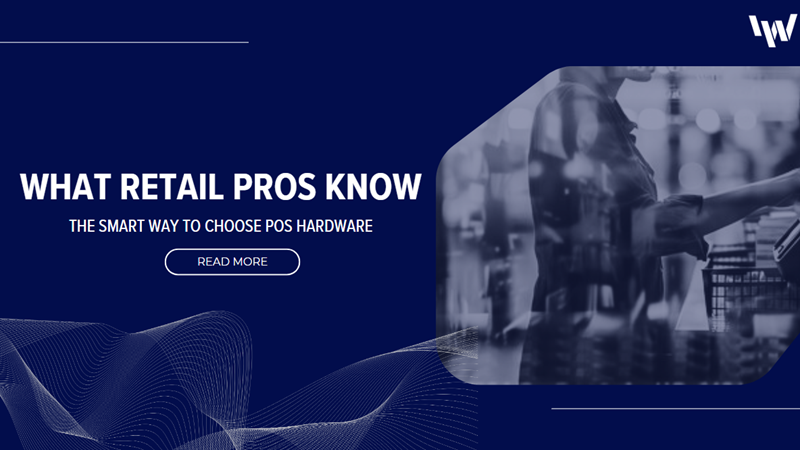How to Choose the Right POS Hardware for Retail Success
In today’s retail environment, the checkout experience isn’t just a transaction—it’s a moment of truth. And behind every smooth scan, tap, and printed receipt is a carefully chosen POS hardware setup doing the heavy lifting. Choosing POS hardware for retail success starts with aligning technology to your day-to-day operations.
According to Global Market Insights, the global retail POS terminal market was valued at $36.7 billion in 2023 and is projected to grow at a CAGR of over 5.5% through 2032. In fact, this growth reflects a broader realization: modern POS hardware isn’t just a tech upgrade it’s a lever for profitability, scalability, and operational efficiency.
Over the years, with nearly 50 years years working alongside retailers from single-location shops to nationwide chains—we’ve learned that success starts by making your hardware work smarter, not harder. This guide breaks down how to select the right point-of-sale hardware for your specific needs, based on what really matters to frontline operators and decision-makers.
Step 1: Start with Your Business Model, Not the Brochure
The hardware you need depends on how your store operates day to day. For instance, are you managing high-volume foot traffic in a grocery store, or providing one-on-one service in a specialty boutique? Each format demands a different setup.
Learn how POS hardware supports better inventory management across Retail, Grocery, Pharmacy, QSR, Hospitality, Convenience/Petroleum and Distribution.
Match Hardware To Store Type
Quick examples:
• For Grocery & QSR, use multi-lane POS terminals, fast receipt printers, integrated scales, durable cash drawers.
• In Boutique & Apparel stores, all-in-one touchscreens, mobile handhelds for floor service.
• Meanwhile, Pharmacy or C-store benefit from self-checkout + fixed terminals + inventory scanners.
To begin with, start by mapping your key workflows and peak transaction times. Then, match hardware to those pressure points.
Step 2: Prioritize Compatibility—Because Replacing Everything Isn’t the Goal
In many cases, not every POS upgrade needs to be full rip-and-replace. In that case, if your current setup works well, look for hardware that integrates with it easily.
Compare platform options like Android vs Windows POS systems to understand compatibility trade-offs.
Check for:
• USB, Ethernet, or Bluetooth compatibility
• Driver support across operating systems
• Backward compatibility with your POS software or cloud platform
Therefore, upgrading doesn’t have to mean starting from scratch.
Step 3: Think Beyond the Counter—Mobility Is the New Standard
Today, more retailers are using mobile POS hardware for line busting, curbside pickup, and in-aisle checkout. As a result, these tools reduce customer friction. They also increase flexibility for your staff.
Useful mobile options:
• Handheld scanners with real-time inventory lookup
• Tablets with integrated payment processing
• Wearable or belt-clip receipt printers
As such, if your team is moving, your tech should too.
Step 4: Plan for Scale, Not Just Startup
Choosing POS hardware for retail is about more than the next 6 months. It’s about ensuring scalability as your business grows across locations. That said, even if you’re starting with one location or a few registers, choose technology that can grow with you.
Look for:
• Modular hardware ecosystems (easy to add devices later)
• Centralized management tools for multi-location retail
• Long-term vendor support and upgrade options
Ultimately, POS hardware that scales is smarter and more cost-effective in the long run.
Step 5: Work with a Vendor Who Knows Retail (Not Just Hardware)
Sure, anyone can sell you a printer. But not everyone understands the operational challenges of retail. In addition, a strong POS hardware partner helps you:
• Identify gaps in your current setup
• Reduce complexity without sacrificing capability
• Train your team and support your rollout
To clarify, ask vendors:
• For example: Do you serve businesses like mine?
• Also: Can I test devices before I commit?
Retail veterans suggest adding these two questions to your shortlist:
• What’s more: Do you offer any pre-rollout testing or pilots?
• More importantly: What happens if something breaks during peak hours?
• Finally: Do you offer real-time support when my stores are open?
Look for partners who provide guidance. Don’t settle for those who only offer equipment.
Closing Thought: Hardware That Works Is Hardware You Don’t Have to Think About
The right POS hardware doesn’t call attention to itself.
It just works quietly, reliably, and in sync with your operations.
At IW, we don’t just ship boxes we help retailers build POS ecosystems that fit how they work. From touchscreens to terminals, from handhelds to self-checkout, we help simplify choosing POS hardware for retail by aligning solutions with your store’s needs.
Let’s Talk
Need help getting started? Let’s walk your floor plan, your workflows, and your future plans and make sure your POS hardware is ready to support them all.
P.S. Trusted by the biggest names in retail, hospitality, QSR, convenience, distribution, and pharmacy we don’t just supply POS hardware, we help design the entire retail POS tech ecosystem. From self-checkout rollouts to mobile-first strategies, we’ve been in the aisles, behind the counters, and on the front lines for over 50 years. Afterall in retail, if your hardware can’t keep up with your hustle, it’s time for an upgrade not a workaround.

